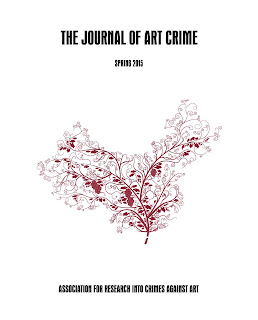Monday, October 10, 2016 -  antiquities looting,antiquities market,Carabinieri Tutela Patrimonio Culturale,cultural repatriation,Mexico,online auctions
antiquities looting,antiquities market,Carabinieri Tutela Patrimonio Culturale,cultural repatriation,Mexico,online auctions
 No comments
No comments
 antiquities looting,antiquities market,Carabinieri Tutela Patrimonio Culturale,cultural repatriation,Mexico,online auctions
antiquities looting,antiquities market,Carabinieri Tutela Patrimonio Culturale,cultural repatriation,Mexico,online auctions
 No comments
No comments
Carabinieri del Comando Tutela Patrimonio Culturale to return stolen archaeological finds to Mexico
 |
| Mexican Embassy in Rome, Italy |
In a ceremony to be held October 11, 2016 at 13:00 at the Mexican Embassy in Rome, Brigadier General Fabrizio Parrulli, Italy's new Commander of the Carabinieri for the Protection of Cultural Heritage, in a ceremony to repatriate illicitly trafficked heritage will return twelve archaeological objects to the Mexican authorities via a handover to the country's ambassador to Italy, Signore Juan Jose Guerra Abud, KBE.
Having succeeding General Mariano Mossa as the head of Italy's specialised Comando Carabinieri Tutela Patrimonio Culturale this year, Brigadier General Fabrizio Parrulli is not stranger to the nuance of international policing. With degrees European Studies as well as International Law and Diplomacy the new general has commanded a team of Iraqi police as part of the NATO mission in Iraq and served as the commander of a training department for police in Baghdad. Closer to home,he has served within the Carabinieri TPC overseeing the its NCO School in Florence.
The twelve pre-Columbian Mesoamerican pieces to be repatriated are from the Mesoamerican Preclassical period (2500 BCC - 200 CE) and the Classical Period (200-1000 CE). The objects seized included a clay head of votive use portraying a character of high rank, another votive bust with disk-shaped earrings and another sculpture with nose ornamentation.
The antiquities were seized by law enforcement between 2013 and 2016 as the result of three separate investigations coordinated by the prosecutor of the Republic of Palmi (RC), Pesaro and Ascoli Piceno. Several of the objects were seized during a customs cross-check of two travellers arriving from Mexico via the Reggio di Calabria "Tito Minniti" Airport, also known as the Aeroporto dello Stretto, in southern Calabria. In a second instance an object had been marketed via "a popular online sales site" where the seller listed the city where the object was currently located and a cellular where he could be reached for further questions. To verify the authenticity of the objects being sold the Carabinieri TPC worked with experts from the Museo Nazionale Preistorico Etnografico Luigi Pigorini in Rome as objects of this type are often reproductions.
The antiquities were seized by law enforcement between 2013 and 2016 as the result of three separate investigations coordinated by the prosecutor of the Republic of Palmi (RC), Pesaro and Ascoli Piceno. Several of the objects were seized during a customs cross-check of two travellers arriving from Mexico via the Reggio di Calabria "Tito Minniti" Airport, also known as the Aeroporto dello Stretto, in southern Calabria. In a second instance an object had been marketed via "a popular online sales site" where the seller listed the city where the object was currently located and a cellular where he could be reached for further questions. To verify the authenticity of the objects being sold the Carabinieri TPC worked with experts from the Museo Nazionale Preistorico Etnografico Luigi Pigorini in Rome as objects of this type are often reproductions.
Mexico is a quintessential example of an antiquities-rich “source nation”. It's a country with an abundance of unprotected archaeological sites that all too often yields artifacts with a commercial value on the art market. It is also a nation, that despite making great strides, still lacks the economic resources necessary to adequately protect much of the remote cultural patrimony found within its borders.
In 2013, art market trend watcher Emma Crichton-Miller noted that Paris had superseded New York as "the most dynamic centre for pre-Columbian art globally, attracting collectors mainly from Europe and America, but also Latin America, the Middle East and Asia." This might explain why traffickers importing illicit goods, appreciate Italy's strategic placement on the European mainland.
The theft and illegal trade of Mexican pre-Columbian antiquities is fed by high demand within the art market, which in turn creates strong incentives for poverty-driven digging. Individuals and teams of looters dig indiscriminately where opportunity avails, without concern for the objects lost archaeological context. They then collect and smuggle valuable finds to market countries by whatever channels are available to them.
What legal instruments are there in Mexico to protect cultural heritage?
Mexico's heritage law, written January 19, 1934 (Art. 27, Political Constitution of the Republic of Mexico; Law on the Protection and Conservation of Monuments. Typical Towns and Places of National Beauty), established national ownership of all immovable archaeological material in the public domain, and precluded the export of all works of art or antiquities without an export license.
This law was further refined in 1972 creating new archaeological zones and extending national ownership of the cultural patrimony to private collections and absolutely forbidding the export of pre-Columbian antiquities. The only exception to this strict mandate is in the case of presidentially-approved gifts and exchanges to foreign scientific institutions and foreign governments for diplomacy purposes.
It is also illegal in Mexico to excavate archaeological sites, even on private land, without the permission of the Mexican government's National Institute of Anthropology and History.






